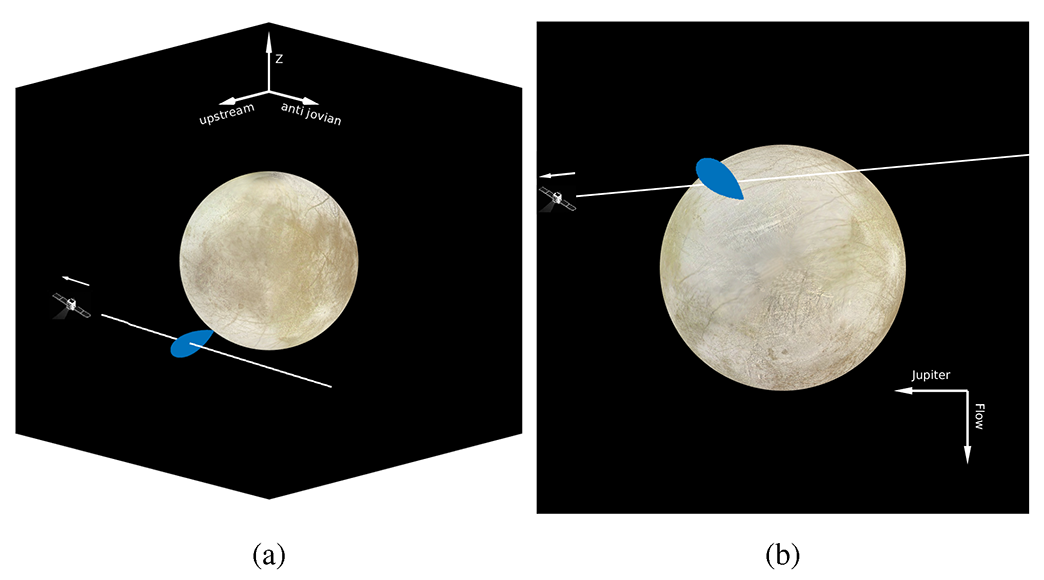Georgia Tech researchers have uncovered a spacecraft's close encounter with Jupiter’s moon Europa. Evidence had been lurking in data obtained 19 years ago by the spacecraft.
Through remote observations, researchers have discovered plumes of water vapor shooting off the surface of Jupiter’s moon Europa. These plumes, more than 200 meters high, are reminiscent of the geysers in Yellowstone Park.
Like Earth, the giant planet Jupiter has a strong internal magnetic field. Indeed, if it were visible to the naked eye, the region of space dominated by this magnetic field – called the magnetosphere of Jupiter – would be the largest object in our solar system. That’s according to Sven Simon, an associate professor in the School of Earth and Atmospheric Sciences (EAS).
Data collected directly by spacecraft indicate that the plumes locally deform Jupiter’s magnetic field near Europa and cause a change in the planet’s magnetospheric plasma flow around the Europa. A water vapor plume at Europa leaves a characteristic “signature” in Jupiter’s magnetic field, which can be identified in data from a spacecraft, Simon says.
Measurements by spacecraft are limited, however, says Lucas Liuzzo, a postdoctoral researcher working with Simon. A spacecraft can measure the magnetic field only along its one-dimensional trajectory, but the interaction between the plumes and their environment is complex and three-dimensional. Therefore, scientists use simulation models to place one-dimensional observations in the context of a three-dimensional interaction.
This approach is used by Simon’s group at EAS, called MOSS (Magnetospheres in the Outer Solar System). Recently, the effort revealed a previously unrecognized encounter between a plume from Europa and a spacecraft almost 20 years ago. The accepted paper was posted Jan. 31, 2019, in Geophysical Research Letters. The work received financial support from NASA.
In 1989, NASA launched the spacecraft Galileo to study the moons of Jupiter, including Europa. Between 1996 and 2000, Galileo made several close flybys of Europa. On Jan. 3, 2000, the spacecraft completed its final Europa flyby, dubbed E26.
Fast forward to 2018. For his Ph.D. project, second-year graduate student Hannes Arnold developed a simulation model of the interaction between Jupiter’s magnetospheric plasma and a possible water vapor plume at Europa. Using this model, Arnold analyzed magnetic field data gathered by Galileo.
The analysis identified signatures that could not be explained solely by the interaction of Jupiter’s magnetic field with Europa, Arnold says. “In recent years, we have learned that a plume could potentially be ‘visible’ in the magnetic field near Europa,” he adds. “Including a plume in our model was our best guess, but still a shot in the dark.”
To identify the origin of these peculiar signatures, Arnold carried out more than 250 simulations of Europa’s plasma environment during Galileo’s final flyby, E26. He arrived at a groundbreaking conclusion: the magnetic field data from this flyby almost 20 years ago contains unambiguous evidence of Galileo’s passage through a plume of water vapor, emanating near a distinct fracture line on Europa’s surface.
The intense outgassing from the plume locally pushes Jupiter’s magnetic field away from Europa, generating a distinct bulge in the magnetic pattern observed by Galileo, Liuzzo says.
Other scientists have modeled the magnetic field signatures from E26, Simon says, but “all of them had overlooked this important feature in the Galileo data.”
In combination with a 2018 study from University of Michigan researchers, the results “provide compelling evidence of persistent plume activity at Europa during the Galileo era,” Arnold says.
“They have immediate relevance for the planning of synergistic measurements during upcoming missions that aim to further characterize plume activity at Europa through in-situ observations.”
Figure Caption
Geometry of the Galileo E26 flyby of Europa as seen (a) from the upstream, Jupiter-averted side and (b) when looking from the Europa’s southern hemisphere. The white line denotes the spacecraft’s trajectory. (Courtesy Geophysical Research Letters)
For More Information Contact
A. Maureen Rouhi, Ph.D.
Director of Communications
College of Sciences




